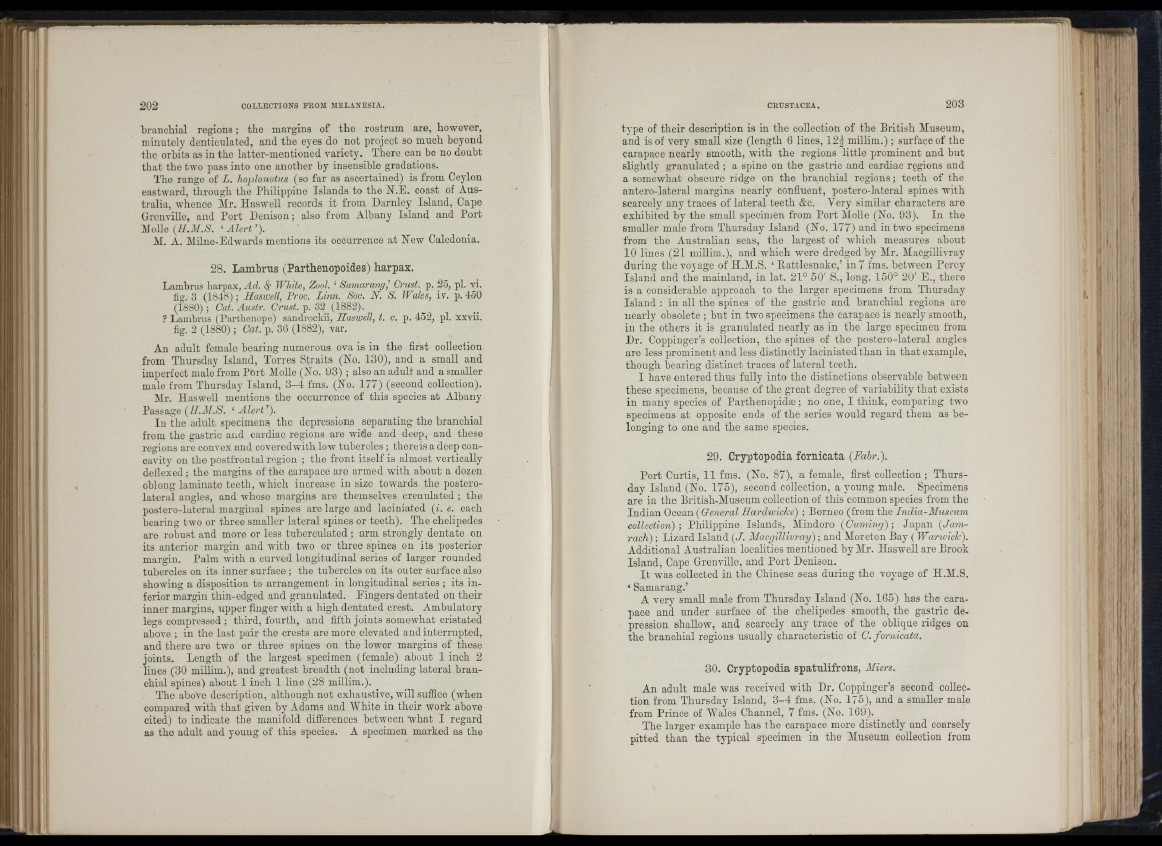
202
branchial regions: the of the rostrum - ''O------7 O ^ are, 1h orw everj,
minutely denticulated, and the eyes do not project so much beyond
the orbits as in the latter-mentioned variety. There can be no doubt
th at the two pass into one another by insensible gradations.
The range of L. hoplonotus (so far as ascertained) is from Ceylon
eastward, through the Philippine Islands to the N.E. coast of Australia,
whence Mr. Haswell records it from Darnley Island, Cape
Grenville, and Port Denison; also from Albany Island and Port
Molle (i^.di.N. ‘AZiri’).
M. A. Milne-Edwards mentions its occurrence at New Caledonia.
28. Lamhrus (Parthenopoides) harpax.
Lamhrus harpax, Ad. 8; White, Zool. ‘ Samarang,’ Crust, p. 25, pi. vi.
fig. 3 (1848); llasioell, Proc. Linn. Soc. N. S. Wales, iv. p. 450
(1880) ; Cat. Aarfr, C/'MSii. p. 32 (1882).
? Lambrus (Parthenope) sandrockii, Haswell, t. c. p. 452, pi. xxvii.
fig. 2 (1880); Cat. p. 36 (1882), var.
An adult female bearing numerous ova is in the first collection
from Thursday Island, Torres Straits (No. 130), and a small and
imperfect male from Port Alolle (No. 93) ; also an adult aud a smaller
male from Thursday Island, 3 -4 fms. (No. 177) (second collection).
Mr. Haswell mentions the occurrence of this species at Albany
Passage (77. J/.N. ‘ A le r t’).
In the adult specimens the depressions separating the branchial
from the gastric and cardiac regions are wide and deep, and these
regions are convex and covereclwith low tubercles ; there is a deep concavity
on the postfrontal region ; the front itself is almost verticaUy
deflexed; the margins of the carapace are armed with about a dozen
oblong laminate teeth, which increase in size towards the posterolateral
angles, and whose margins are themselves crenulated; the
postero-lateral marginal spines are large and laciniated (i. e. each
hearing two or three smaller lateral spines or teeth). The chelipedes
are robust and more or less tuberculated ; arm strongly dentate on
its anterior margin and with two or three spines on its posterior
margin. Palm with a curved longitudinal series of larger rounded
tubercles on its inner surface ; the tubercles on its outer surface also
showing a disposition to arrangement in longitudinal series; its inferior
margin thin-edged and granulated. Fingers dentated on their
inner margins, upper finger with a high dentated crest. Ambulatory
legs compressed ; third, fourth, and fifth joints somewhat cristated
above ; in the last pair the crests are more elevated and interrupted,
and there aro two or throe spines on the lower margins of these
joints. Length of the largest specimen (female) about 1 inch 2
lines (30 millim.), aud greatest breadth (not including lateral branchial
spines) about 1 inch 1 line (28 millim.).
The above description, although not exhaustive, will suffice (when
compared with th a t given by Adams and White in their work above
cited) to indicate the manifold differences between wbat I regard
as the adult and young of this species. A specimen marked as the
type of their description is in the collection of the British Museum,
and is of very small size (length 6 lines, 1 2 | millim.) ; surface of the
carapace nearly smooth, with the regions little prominent and but
slightly granulated ; a spine on the gastric and cardiac regions and
a somewhat obscure ridge on the branchial regions; teeth of the
antero-lateral margins nearly confluent, postero-lateral spines with
scarcely any traces of lateral teeth &c. Very similar characters are
exhibited by the small specimen from Port Alolle (No. 93). In the
smaller male from Thursday Island (No. 177) and in two specimens
from the Australian seas, the largest of which measures about
10 lines (21 millim.), and which were dredged by Mr. Alacgillivray
during the voyage of H.Al.S. ‘ Rattlesnake,’ in 7 fms. between Percy
Island and the mainland, in lat. 21° 50' S., long. 150° 20' E., there
is a considerable approach to the larger specimens from Thursday
Island : in all the spines of the gastric and branchial regions are
nearly obsolete ; but in two specimens the carapace is nearly smooth,
in the others it is granulated nearly as in the large specimen from
Dr. Coppiuger’s collection, the spines of the postero-lateral angles
are less prominent and less distinctly laciniated than in th a t example,
though bearing distinct traces of lateral teeth.
I have entered thus fully into the distinctions observable between
these specimens, because of the great degree of variability th at exists
in many species of Partheuopidas; no one, I think, comparing two
specimens at opposite ends of the series would regard them as belonging
to one and the same species.
29. Cryptopodia fornicata (Fahr.).
Port Curtis, 11 fms. (No. 87), a female, first collection ; Thursday
Island (No. 175), second collection, a young male. Specimens
are in the British-Museum collection of this common species from the
IndiauOcQaii (General Hardivicke) ; Borneo (from the India-Aluseum
collection); Philippine Islands, Alindoro (Cuminy); Japan (Jamrach)
; Lizard Island (J. Alacgillivray); and Aloreton Bay ( Warwick).
Additional Australian localities mentioned by Air. Haswell are Brook
Island, Cape Grenville, and Port Denison.
I t was collected in the Chinese seas during the voyage of H.M.S.
‘ Samarang.’
A very small male from Thursday Island (No. 165) has the carapace
and under surface of the chelipedes smooth, the gastric depression
shallow, and scarcely any trace of the oblique ridges on
the branchial regions usually characteristic of C. fornicata.
30. Cryptopodia spatulifrons, Aliers.
An adult male was received with Dr. Coppinger’s second collection
from Thursday Island, 3 -4 fms. (No. 175), and a smaller male
from Prince of AVales Channel, 7 fms. (No. 169).
The larger example has the cai'apace more distinctly and coarsely
pitted than the typical specimen in the Museum collection from
; ■( I